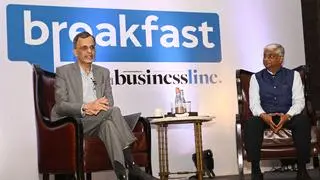Saturday night should be a night of celebration at Kudankulam as the first of two units of the nuclear power project is expected to ‘go critical’.
Meaning, the self-sustaining nuclear reaction needed to generate power will commence. In 15 days, the first units of electricity should start flowing into the grid — an event that has been awaited for nearly a quarter of a century.
Given the opposition to the project and its five-and-a-half year delay, officials are more likely to be hoping nothing goes wrong rather than celebrating.
On Thursday, the Atomic Energy Regulatory Body (AERB) gave project operator Nuclear Power Corporation of India the green light to start the process that would lead to the plant going critical.
Criticality, here, is a self-sustaining chain reaction in which neutrons break open nuclei of radioactive Uranium-235 atoms to release more neutrons, which, in turn, break more nuclei, generating heat all the while.
The heat will be used to produce steam. For about a fortnight the steam will not be used to generate electricity, as the project managers monitor how the plant’s equipment operates. After 15 days, the steam will be used to drive turbines and produce electricity that will be pumped into the grid.
Gain for the south
Officials expect the 1,000 MW Unit-1 to be operating at a shade less than a third of its capacity, but a rapid ramp-up has been planned and the plant will be gradually taken to full capacity. Commercial operations will begin in 45 days, and presumably, be inaugurated in the presence of high-level dignitaries.
The electricity generated at Kudankulam will be supplied to the four southern states. The biggest beneficiary will be the project’s home state, Tamil Nadu, which will get 925 MW out of the 2,000 MW generated. As such it will get around 460 MW from the first unit.
Last year, S. K. Jain, the then Chairman and Managing Director of NPCIL, had said that Kudankulam’s power would be sold at Rs 2.65 a kWhr. Now, although there has been a spike in costs due to delays in execution and exchange-rate fluctuation, the power will be sold at tariffs “below Rs 3”, said a senior NPCIL official.
This is a matter of delight for electricity distribution companies in the South, as their average cost of power is well above Rs 3 a unit. In Tamil Nadu, for instance, the state distribution company incurred a cost of Rs 5.98 per unit in 2012-13, whereas its average realisation was only Rs 3.79 a unit, leaving a deficit of Rs 2.19 a unit. In Andhra Pradesh, the four electricity distribution companies are expect to incur an average cost per unit of Rs 4.07 in 2013-14.
The 2,000-MW Kudankulam project has its origins in the Soviet era, when an inter-governmental agreement, signed in November 1988, paved the way for India to set up the project with Soviet-supplied reactors and fuel.
Long wait
However, things came to a standstill when the Soviet Union disintegrated and it fell upon India to pick up the threads with Russia. Diplomacy had to cut through international pressure, mainly American, as India opposes the Nuclear Non Proliferation Treaty. Pokhran-II, in 1998, compounded the problems.
However, the hurdles were overcome and on November 6, 2001, India and Russia signed an MoU that led to the commencement of construction on March 31, 2002.
The first of the two units was to begin electricity generation in December 2007. The five-and-a-half-year delay has caused a cost overrun of Rs 4,000 crore.








Comments
Comments have to be in English, and in full sentences. They cannot be abusive or personal. Please abide by our community guidelines for posting your comments.
We have migrated to a new commenting platform. If you are already a registered user of TheHindu Businessline and logged in, you may continue to engage with our articles. If you do not have an account please register and login to post comments. Users can access their older comments by logging into their accounts on Vuukle.